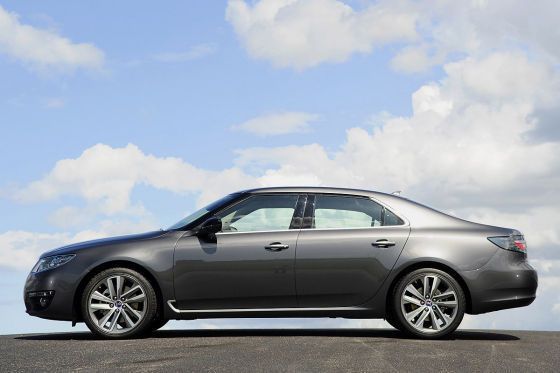Who Got What In The Saab-BAIC Deal?
With the intellectual property and tooling for 9-5 and 9-3 models headed for Beijing, there’s less to Saab than ever. Sort of. The BAIC deal actually proved to be less dramatic than previously thought, netting the Swedish GM subsidiary a mere $197m according to Automotive News [sub]. BAIC had just obtained a $2.93b line of credit with Bank of China, so there was nothing stopping them from buying more… except GM’s unwillingness to hand over modern platforms. What BAIC did get out of the deal still isn’t entirely clear, but what is clear is that GM has received nothing from the Saab sale so far. That $197m was deposited into Saab’s Swedish account, according to sources speaking to di.se.
Motor Trend tries its hand at parsing the information that is available on the deal, and one thing seems certain: BAIC did not score anything related to the Epsilon II-based new 9-5. MT wrestles with the sparse data:
Depending on the generation of 9-3 tooling and powertrains sold, BAIC could get roughly the same equipment, as the two cars shared platforms and powertrains early on. Should BAIC get the second-generation 9-3, it would get the newer Epsilon platform and updated four-cylinder gasoline and diesel turbocharged engines. It’s more likely, though, that BAIC will get the more-outdated first-generation equipment [GM29000]. BAIC will not get access to the new, second-generation 9-5.
Figure that out. China Daily adds:
Jia Xinguang, chief analyst with the Chinese National Automotive Industry Consulting and Development Corp, said the deal is not that significant for BAIC as the production platforms of Saab 9-5 and 9-3 have been shut down due to the old and outdated technologies and also have low efficiency and utility.
However, Jia is optimistic about BAIC acquiring Saab’s powertrain systems, including turbo-charged engine and gearbox technologies, “which can fill the gap between China and global players in the transmission segment”.
He also hoped that “maybe the locally produced sports cars with Saab 9-3 and 9-5’s extraordinary performance will be popular among Chinese consumers”.
Which, in combination with the low value of the deal, indicates that the modern GM technology underpinning the new 9-5 is still up for grabs, along with Saab’s brand name and Swedish assets. Indeed, Saabsunited reports that the technology purchased was for 2004 model-year 9-3 and 9-5 specs, meaning both the GM29000 and the Epsilon I were part of the deal.
Saab makes it sound like it wants to be BAIC’s mentor, telling CD “We have developed a good relationship with BAIC and look forward to working with them to integrate the Saab technology into their future vehicles.” But along came a Spyker…
More by Edward Niedermeyer
Latest Car Reviews
Read moreLatest Product Reviews
Read moreRecent Comments
- DesertNative More 'Look at me! Look at me!' from Elon Musk. It's time to recognize that there's nothing to see here, folks and that this is just about pumping up the stock price. When there's a real product on the ground and available, then there will be something to which we can pay attention. Until then, ignore him.
- Bkojote Here's something you're bound to notice during ownership that won't come up in most reviews or test drives-Honda's Cruise Control system is terrible. Complete trash. While it has the ability to regulate speed if there's a car in front of you, if you're coasting down a long hill with nobody in front of you the car will keep gaining speed forcing you to hit the brakes (and disable cruise). It won't even use the CVT to engine brake, something every other manufacturer does. Toyota's system will downshift and maintain the set speed. The calibration on the ACC system Honda uses is also awful and clearly had minimum engineering effort.Here's another- those grille shutters get stuck the minute temperature drops below freezing meaning your engine goes into reduced power mode until you turn it off. The Rav4 may have them but I have yet to see this problem.
- Sobhuza Trooper "Toyota engineers have told us that they intentionally build their powertrains with longevity in mind."Boy, that's pretty hateful. I suppose some greedy people who would pick Toyota would also want to have greater longevity for themselves. But wouldn't we all rather die at 75, while still looking cool than live to be 85 and look like a doddering old man?
- Kwik_Shift_Pro4X Neither. They're basically the same vehicle.
- Analoggrotto 1. Kia Sportage2. Hyundai TucsonRugged SUVs which cater to the needs of the affluent middle class suburbanite which are second only to themselves, these are shining applications of Hyundai Kia Genesis commitment to automotive excellence. Evolving from the fabled Hyundai Excel of the 90s, a pioneering vehicle which rivaled then upstart Lexus in quality, comfort and features long before Hyundai became a towering king of analytics and funding legions of internet keyboard warriors.


































Comments
Join the conversation
Clear as mud.
Who cares about the 9-5 or 9-3? As long as they didn't sell/license the 900 to BAIC, I won't freak out. And as far as I'm concerned, that's where the value remaining in the brand still lies. New SAAB is too embedded into GM to extricate easily? Fine, who cares. Let them keep all that crap. Just give the brand/mark, plus all the old pre-GM designs and related IP back to the Konig' consortium and take a fire sale price. Problem solved. No one liked all that GM crap in their SAABs anyway. That's what killed their appeal.